Decorative stone in the interior of the kitchen

The use of decorative stone in the interior of the kitchen helps to take a fresh look at the design of the room in which food is cooked and eaten. Modern designers very often use this material in their projects. In order for the stone to blend harmoniously into the kitchen interior, you need to know some of the features of such a decor.
Peculiarities
Decorative stone in the kitchen carries positive energy and invariably attracts the eye due to the pronounced naturalness of the texture, color and volume of the embossed surface. It allows a person to plunge into the natural world without leaving their home.
The presence of stone finishing in the interior gives the room a feeling of comfort and stability. To create the effect of monumentality and permanence, it is not necessary to lay out the entire kitchen with a stone; it will be enough to use it in separate areas, such as a place for eating, a work area and others.
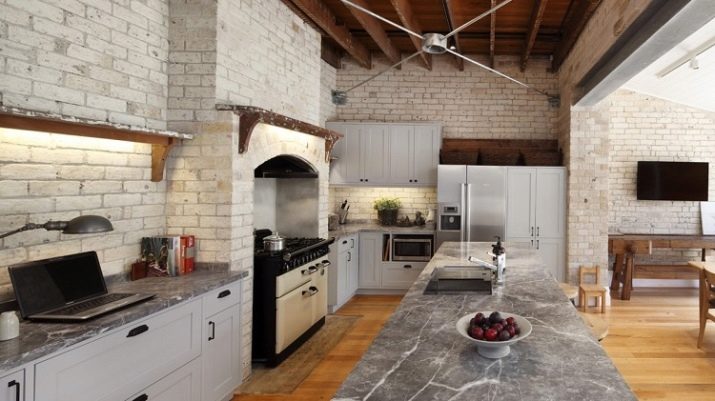

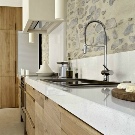
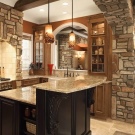
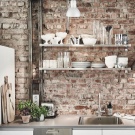
Decorative stone as a finishing material is chosen for kitchens located in apartments and in private households. The stone will bring the kitchen in the apartment closer to eco-style, create more comfortable conditions, fill the entire room with special light and warmth. In houses, the presence of stone decoration will remind you of medieval times, create a romantic mood in the kitchen and beyond.
Stone cladding works well with other natural materials such as wood or textiles. It is also better to borrow a color scheme in harmony with the stone surface from nature. All shades of beige, brown, green and blue are perfectly combined with a stone.

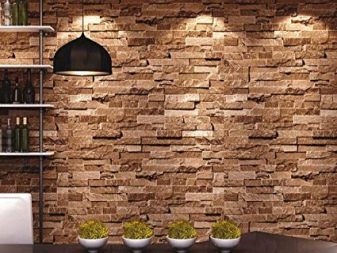

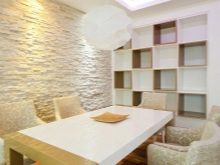
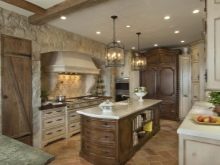
Advantages and disadvantages
Like any finishing material, decorative stone has advantages and disadvantages, taking into account the conditions of its use. The advantages of this material are the following aspects.
- Environmental friendliness. Since the raw materials for the production of artificial stone are natural materials, its harmlessness is not questioned. This indicator is especially important for rooms intended for cooking and eating, as well as spending a lot of time in them.
- Durability. The internal microclimate of the kitchen requires the finishing materials to have a certain degree of resistance to external factors. In this case, the decorative stone is resistant to high temperatures and high humidity. It is especially worth noting the incombustibility of the stone, which is extremely important in rooms where fire can be used. Over time, the stone surface practically does not deteriorate and does not change its appearance.
- Wide choose. Decorative material provides an opportunity to choose the most suitable color scheme and texture. The surface of the masonry can be glossy, matte, smooth or embossed.
- Ease of maintenance. Caring for surfaces made of decorative stone does not require much effort and time-consuming, as it has an antistatic effect, that is, it does not attract dust particles. And since the stone is not afraid of moisture, it is easy to wash and wipe it with a damp cloth.
- Ease of installation. Carrying out installation work of decorative stone does not require special skills.Often, an installation error, the appearance of chips and masonry inaccuracies are perceived as an original design development.
- Aesthetics of appearance. Attracting attention, the stonework in the kitchen makes you enjoy the aesthetic effect it produces. Very often, the stone becomes the highlight of the kitchen, and the place of its masonry is the most attractive in the room.
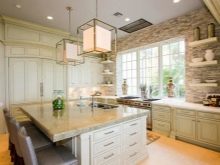

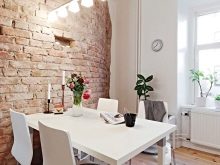
The disadvantages of decorative stone are the following facts and circumstances.
- In comparison with such finishing materials as ceramic tile or mosaic, decorative stone has a more modest set of texture options, colors and shades.
- The price category of some materials is much lower than that of stone. In this context, ceramic tiles, plaster and wallpaper, which are also used to decorate the kitchen, can compete with it.
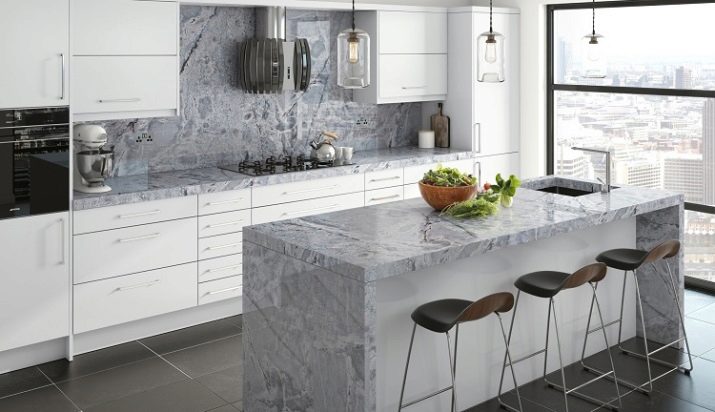
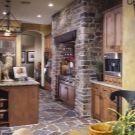
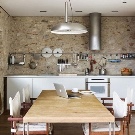
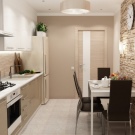
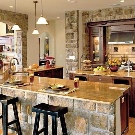
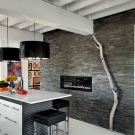
Views
Decorative stone can be of natural or artificial origin. Natural materials are always more valuable than artificial ones, but artificial stone also has a lot of advantages in comparison with natural.
Natural
Natural or wild stone has a unique appearance and a unique design created by nature itself. The environmental friendliness of natural stones and the absence of chemistry in their composition is undeniable. There are several types of wild stones that are used for interior decoration in the kitchen. External and physical properties may vary depending on its type.
- Marble. Thanks to the colored veins, the marble material has a very beautiful texture. At the same time, it is considered one of the most capricious natural stones, which is afraid of processing with chemicals, therefore, in order to avoid its destruction, it is recommended to cover the marble masonry with a protective layer.
- Granite. It is characterized as a very durable natural material. Its color scheme depends on the place of origin. Granite masonry perfectly retains all its characteristics in conditions of high humidity and advanced temperatures.

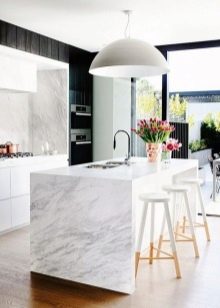
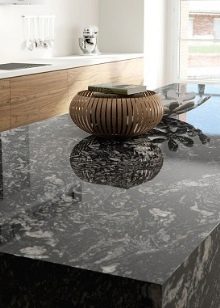
- Travertine. This type of stone has excellent resistance to mechanical damage, but does not accept contact with chemicals. Travertine has a porous structure, so it is very lightweight. The technique of artificial aging of travertine is sometimes used. To do this, its pores are filled with special mastic and polished, forming a unique pattern. The characteristic color range of travertine is from white to gray, pastel colors prevail.
- Dolomite. This stone is very similar to granite in its strength characteristics. In addition, it has excellent heat resistance and is actively used for lining furnaces. With its help, you can create not only masonry, but also an imitation of brick. Dolomite ranges in color from white to brown.
Despite its excellent strength characteristics, dolomite is destroyed by the action of hydrochloric acid, therefore, it is strictly not recommended to use care products with its content.
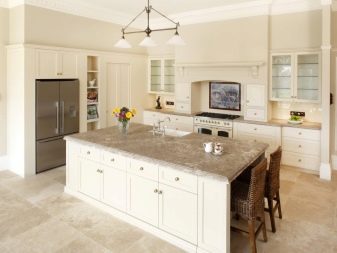

- Slate. This wild material has a unique structure and is ideal for layering. It is quite thin in thickness and has a smooth surface. Its color scheme is quite varied. Shale beds are yellow, brownish, burgundy, green and multicolored.
- Sandstone. Belongs to porous rocks and is used for facing wall panels, as well as columns, individual islands. Due to the fact that sandstone is a little problematic to wash, it is recommended to lay it away from the cooking area.
The hardness of this material depends on the limestone or quartzite binder.
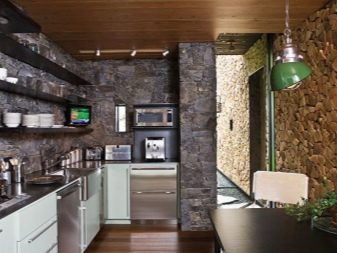
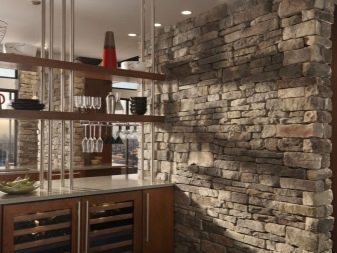
- Onyx. This stone combines strength and attractiveness. It is characterized by an overflow of dark and light layers. Onyx has the ability to transform light rays, and thanks to a special internal illumination, it is possible to achieve a 3D effect.Using it in decoration makes the kitchen not only stylish and attractive, but mesmerizing with its beauty.
- Pebbles. River or mountain pebbles are also used for interior decoration in the kitchen. It is worth noting that in the case of using pebbles for laying an apron, it must be carefully protected from excessive exposure to moisture in order to avoid the formation of mold and mildew.
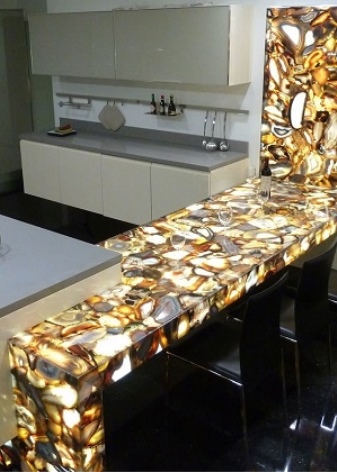

Artificial
An artificial analogue of natural stone is very often used when carrying out finishing work in the kitchen. Experts note the high degree of wear resistance of this material and its excellent aesthetic properties.
Modern manufacturers of artificial materials offer imitation of various natural stonessuch as granite, marble, onyx, sandstone and others. It can be produced as piece items or in small groups on special panels.
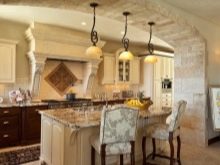
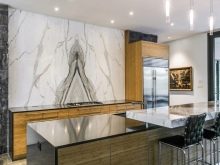
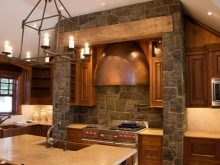
The kitchen often uses a flexible artificial material made from a cut stone on the surface of the fabric. In order to protect such a canvas from various kinds of external influences, it is covered with special protection. It is convenient to finish not only straight, but also curved surfaces with a flexible stone.
Also popular is an artificial material made under a brick. The appearance of the bricks allows you to reproduce the effect of real brickwork. The species assortment of this material allows you to select items of various colors and sizes.

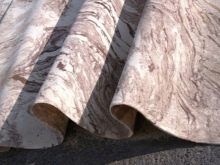
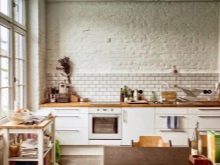
Finishing options
Decorating a kitchen with a stone is quite an expensive pleasure, but the result of the work is always amazing. Designers offer options for laying out a stone wall as a whole or in a separate small area.
- Kitchen apron. The apron area in the kitchen is more demanding in terms of finishing in comparison with other areas. Here it is necessary to use those materials that are insensitive to water, high temperatures, as well as cleaning and detergents. Both natural and artificial stone are used to create an apron. In order to insure against the appearance of fungus and mold, it is necessary to cover the apron with special means.
- Several walls. When laying out two or more walls with decorative stone, you need to remember that visually masonry narrows the space, so this finish is not suitable for a kitchen with a small area. The most common decor is stone decoration on two adjacent or parallel walls, combined with wooden furniture.
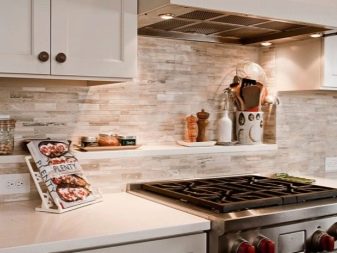
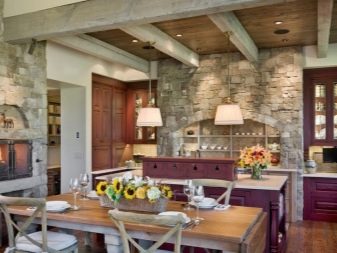
- One wall. The laying of decorative stone on one wall looks impressive if there is no furniture on it at all or in part. Such a wall instantly attracts attention and often a dining group is located against its background.
- Part of the wall. If the area of the kitchen is not very large, then a small fragment of the wall is laid out with a stone, which can be located both in the upper and in the lower part of it.
The stone looks very impressive in tandem with matching wallpaper.
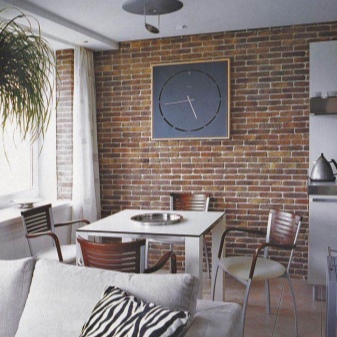
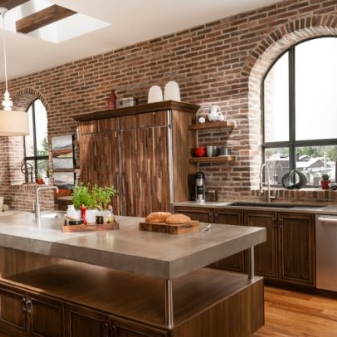
- Stone panel. The original design solution - a stone panel on the wall, will not leave anyone indifferent. This is a very beautiful and stylish decor that can be easily removed if necessary.
- Shelves and niches. Using decorative stone, you can very effectively beat shelves and niches. In this case, functionality goes well with the aesthetics and style of stone decor.
- Corners, arches and doorways. With the help of a stone arch, you can make a beautiful design for a corner, arch or doorway. All these elements will play in a new way, acquire a noble look and become a highlight of the interior.
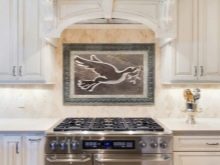

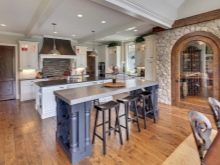
Beautiful examples
Stone with wallpaper
An interesting combination of decorative stone and photo wallpaper makes the interior design even more attractive. The color of the wallpaper can be chosen to match the masonry or different from it. This combination is commonly used to visually lighten a stone wall.
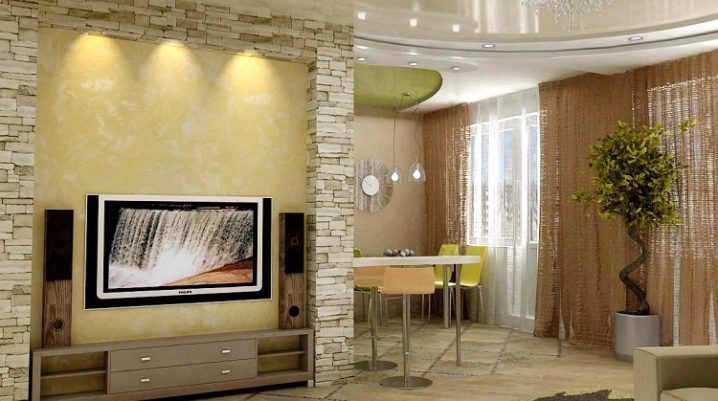
Stone with wood
Stone masonry and wooden interior elements look incredibly harmonious next to each other. The naturalness of these materials leaves no reason to doubt their successful partnership. They mutually emphasize each other's beauty. Kitchen cabinets, doors, floors and much more can be wooden.

Stone floor
Stone mosaic on the floor is a prerogative of the Mediterranean style, but it fits perfectly with other styles. The stone floor looks not only original, but also very beautiful. All stone floors have one drawback - it leaves no chance for fallen dishes to survive on its surface.
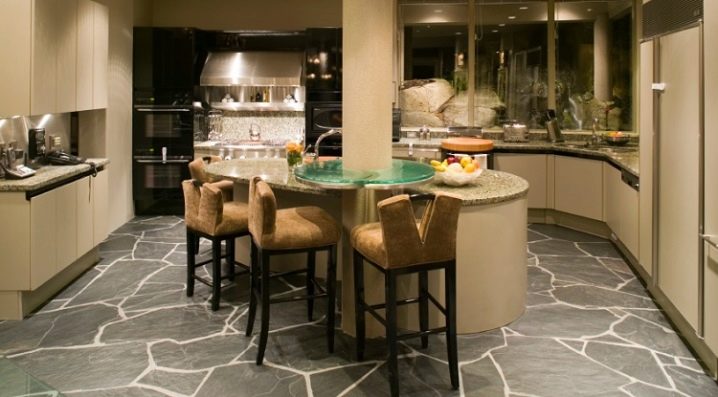
Tandem with white
The beauty and versatility of white go well with the natural roughness of the stone. The stonework in the corner area where the oven and microwave are located are reminiscent of medieval ovens.
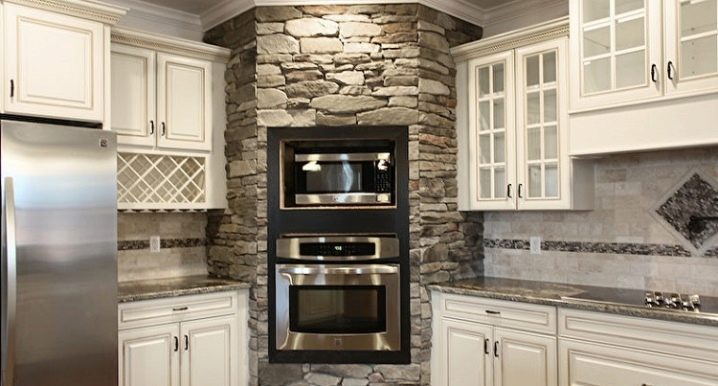
In the next video, you will be laying decorative plaster stone.













The comment was sent successfully.